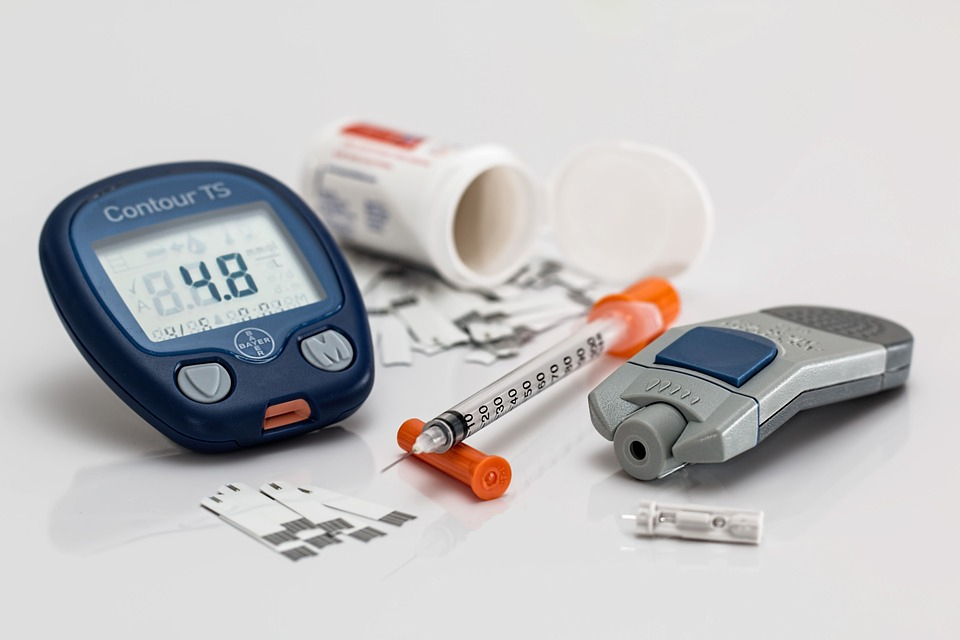Muscle loss is a significant quality-of-life issue for patients with diabetes.
Diabetes is extremely common in the older adult population, affecting more than one-quarter of Americans aged 65 and older.(1) It’s increasingly recognized that individuals with type 2 diabetes—who comprise the vast majority of all diabetes cases—are vulnerable to sarcopenia—excessive age-related muscle loss. Although muscle loss can begin in persons with diabetes even at younger ages, it’s of particular concern among older adults.
 “People with diabetes are living longer now, which is incredibly exciting,” says Rita Kalyani, MD, MHS, an associate professor of medicine in the division of endocrinology, diabetes, and metabolism at Johns Hopkins School of Medicine. But “it’s important to recognize [the potential for accelerated muscle loss] because it can significantly impact quality of life for people with diabetes and also mortality.”
“People with diabetes are living longer now, which is incredibly exciting,” says Rita Kalyani, MD, MHS, an associate professor of medicine in the division of endocrinology, diabetes, and metabolism at Johns Hopkins School of Medicine. But “it’s important to recognize [the potential for accelerated muscle loss] because it can significantly impact quality of life for people with diabetes and also mortality.”
What Is Sarcopenia?
Muscle loss is natural with advancing age. It is routine for individuals to lose 3% to 8% of their muscle mass per decade beginning at age 30, and the rate of decline is even higher after the about age 60.2 Muscle strength declines even more rapidly—at a rate of 3% to 4% per year in men and 2.5% to 3% per year in women by the age of 75.3
While some muscle loss is typical, sarcopenia refers to a condition of accelerated muscle loss. Earlier definitions of sarcopenia focused exclusively on loss of muscle mass as the key determinant of the condition, but more recent definitions have recognized that muscle strength and function are equally important for predicting adverse outcomes.(4-6) Thus, newer definitions for sarcopenia have included low walking speed and grip strength alongside low muscle mass.(5) Sarcopenia is associated with an increased risk of falls, functional decline, frailty, and mortality.(7)
How Strong Is the Connection Between Diabetes and Sarcopenia?
The link between diabetes and sarcopenia is well established. In a study of 810 Korean adults, 15.7% of participants with diabetes were found to have sarcopenia, compared with just 6.9% of participants without diabetes.(8) A later study led by the same author, also in Korea, produced similar findings: in a sample of 414 adults aged 65 or older, participants with type 2 diabetes had significantly lower muscle mass (defined as appendicular mass/height) than did those without diabetes.(9) A link between low muscle mass and diabetes has been found in several other populations as well.(5,10)
Multiple studies have also linked diabetes to reduced muscle strength. In a cross-sectional investigation of 1,391 adults aged 60 to 70 years from the Hertfordshire (UK) cohort study, men newly diagnosed with diabetes had significantly lower grip strength than did those without diabetes.11 The effect sizes were smaller in women, but the trend was the same for both genders. Similarly, among 1,840 participants aged 70 to 79 years in the Health, Aging, and Body Composition study, subjects with type 2 diabetes showed a greater loss of both muscle mass and a greater loss of leg strength and leg muscle quality (though not arm strength/quality) over three years, compared with those without diabetes.(12) These declines were attenuated after adjustment for demographics, body composition, physical activity, and other factors, but the association remained significant.
The association between sarcopenia and diabetes has led some researchers to argue that sarcopenia is probably one of the underlying mechanisms that explains the reduced functional ability and mobility that is often seen in older patients with type 2 diabetes.(13)
Mechanisms: How Diabetes Contributes to Sarcopenia
While diabetes accelerates the process of muscle loss, the mechanisms aren’t yet thoroughly understood. “There are probably multiple underlying pathways linking the observational findings that we see between type 2 diabetes and accelerated loss of muscle,” Kalyani says.
 The presence of insulin resistance, which is the key feature of type 2 diabetes, appears to be a major pathway. “Insulin resistance is associated with decreased protein synthesis in the muscle,” Kalyani says. One of the key roles of insulin is to drive nutrients (ie, glucose) from the blood into skeletal muscle tissue and stimulate protein synthesis. In type 2 diabetes, however, insulin signaling is impaired; insulin is not able to effectively drive glucose into the muscle tissue, and the muscle cannot synthesize new protein rapidly enough to keep pace with natural muscle degradation.(13)
The presence of insulin resistance, which is the key feature of type 2 diabetes, appears to be a major pathway. “Insulin resistance is associated with decreased protein synthesis in the muscle,” Kalyani says. One of the key roles of insulin is to drive nutrients (ie, glucose) from the blood into skeletal muscle tissue and stimulate protein synthesis. In type 2 diabetes, however, insulin signaling is impaired; insulin is not able to effectively drive glucose into the muscle tissue, and the muscle cannot synthesize new protein rapidly enough to keep pace with natural muscle degradation.(13)
Insulin resistance is linked not only to decreased protein synthesis but also to mitochondrial dysfunction. Individuals with diabetes frequently have decreased mitochondrial function, which again appears to contribute to the impairment of muscle function (possibly in part because these mitochondrial alterations may increase insulin resistance).(5)
Diabetes can also promote sarcopenia via peripheral neuropathy. Approximately 30% to 50% of diabetes mellitus patients experience peripheral neuropathy, and the condition has been shown to be an independent risk factor for sarcopenia in individuals with diabetes.(14) “Nerves are needed to help the muscles contract properly,” says John Morley, MD, a professor of medicine in the division of geriatric medicine at the Saint Louis University School of Medicine. “My leg muscles are almost certainly contracting as I sit here. If I’ve got some degree of neuropathy, I won’t get the same amount of contraction.”
Still other factors also may play a role in causing muscle loss in the context of diabetes. People with diabetes frequently have higher than normal levels of inflammatory cytokines, including tumor necrosis factor and interleukin.(6) Such cytokines have been shown to have negative impacts on both muscle mass and strength in older adults.(15) In addition, “people with diabetes are also more likely to have hypothyroidism, and people with hypothyroidism get a myopathy of the legs as well,” Morley says. “So you should always be thinking, if you see a diabetic who’s lost a lot of muscle, ‘Could this be due to something else, like low thyroid’?”
Thus, a wide variety of factors likely contribute to the connection between diabetes and sarcopenia. Some data suggest that these varying mechanisms come into play even in individuals who are comparatively young or who are comparatively early in the disease process. Kalyani and her colleagues examined a group of 984 participants from the Baltimore Longitudinal Study of Aging and found that loss of muscle function as a result of hyperglycemia was seen in some patients who were only in their 40s. Interestingly, peripheral neuropathy appeared to be a contributing factor. Also of note in this investigation is the fact that hyperglycemia affected muscle strength and quality even for patients with blood glucose levels in the prediabetes range.(16)
A Bidirectional Association: How Muscle Loss Can Lead to Diabetes
Until recently, scholarly attention on the connection between diabetes and sarcopenia has focused on diabetes as a cause of sarcopenia. “Clinically the direction that we think about most is accelerated muscle loss being a complication of diabetes—that people who have diabetes develop accelerated muscle loss over time,” Kalyani says. “But it’s possible that the reverse direction is also true.”
Kalyani herself explored this hypothesis in a recent study of 1,855 US adults (baseline mean age of 58.9 years). She and her colleagues found that men—though not women—who had a higher percentage of total or leg lean body mass had a lower risk of developing diabetes over the seven-year average follow-up period, even after adjusting for race.(17) The findings are in line with a previous study of young and middle-aged Korean adults (median age of 39 years at baseline) showing that individuals in the lowest quartile of relative muscle mass had a two-fold higher risk of developing diabetes than did those in the highest quartile over an average of nearly three years of follow up.(18)
According to Kalyani, the findings make sense. “Skeletal muscle is the main site of glucose uptake in the body after we eat,” accounting for about 80% of glucose clearance in a healthy individual. “So if we don’t have enough skeletal muscle, then the glucose is not taken up by the body, and it stays in the blood. As a result, your glucose levels are higher, and over time that could lead to the development of diabetes,” Kalyani says.
A recent review on the bidirectional relationship between diabetes and sarcopenia supports Kalyani’s hypothesis, arguing that loss of skeletal muscle mass and function is both a cause and a consequence of diabetes. As for how muscle loss can cause diabetes, the review supports Kalyani’s assertion that muscle loss results in a diminished target for insulin, altering glucose regulation. But the review also notes another mechanism by which muscle loss can lead to diabetes—namely, it can contribute to a decreased metabolic rate and a decrease in physical activity, which can cause inter- and intramuscular adipose tissue accumulation, in turn leading to insulin resistance.(19)
One of the difficulties associated with type 2 diabetes is that the disease doesn’t necessarily produce obvious symptoms in the early stages, meaning that some patients may not be diagnosed until after they have already developed cardiovascular problems.
However, the recognition that loss of muscle strength predicts risk of diabetes has led to new possibilities for diagnosing type 2 diabetes in its earlier stages. A recent study led by researchers at Oakland University in Rochester, Michigan, used data from more than 5,000 participants in the National Health and Nutrition Examination Surveys to identify specific cut points of handgrip strength that take into account age, sex, and body weight and that indicate the presence of type 2 diabetes in adults that appear otherwise healthy.(20) According to the authors, these cut points can be a useful screening tool for identifying diabetes at earlier stages and getting patients into treatment sooner.
The Role of Blood-Glucose Management in Preventing Muscle Loss
The growing body of research on the connection between diabetes and sarcopenia has raised an important question: Does lowering blood glucose help preserve muscle mass?
According to Morley, there’s little research on that question, but diabetes medications that control blood glucose levels likely do have a role to play in treating (and preventing) muscle loss among older adults with diabetes. “If you’re using something like metformin or the gliptins, those improve insulin resistance. Improving insulin resistance will allow you to get more nutrients into your muscle tissue.”
The question of whether lowering blood glucose helps prevent sarcopenia is relevant because most clinical practice guidelines for older adults with diabetes recommend less aggressive glucose control as people get older. “The older adult population is heterogenous—there are some people who have long life expectancy, some have greater life expectancy, some are at greater risk for polypharmacy or hypoglycemia,” Kalyani says. “So in general glucose targets for older adults are not as strict as they are for younger adults.”
Unfortunately, Kalyani says, it’s possible that these relaxed targets may exacerbate muscle loss in vulnerable older adults. Key clinical trials on which clinical management guidelines for blood glucose have been based haven’t usually included older adults, so there’s no way to know at present. According to Kalyani, future research is needed to better understand the effects of glucose-lowering on muscle mass in older adults.
 The Importance of Exercise
The Importance of Exercise
While diabetes medications may have a role to play in lowering blood glucose and in staving off muscle loss, Morley is adamant that no medication is as beneficial for treating sarcopenia as physical exercise. “The major treatment is resistance exercise,” Morley says. “You can argue that aerobic exercise is also useful, but if you’re going to do anything as a diabetic, you want to do resistance exercise to build your muscle bulk.” For older adults with sarcopenia, the key exercises he recommends are walking around the block four to five times, doing some weight lifting, and sitting in a chair and getting up ten times in a row as fast as possible.
Kalyani agrees on the importance of activity. “Physical exercise is always recommended,” in part to promote fat loss and maintain muscle mass, both of which can improve glucose levels. Those recommendations apply equally to both younger and older adults, she says. “As long as they can tolerate the exercise they are doing, we definitely recommend that, particularly muscle strengthening exercise and resistance activity.”
Recommendations for Clinicians
• Take seriously the fact that patients with type 2 diabetes are vulnerable to muscle loss. “Accelerated muscle loss is an underappreciated condition that occurs in people with type 2 diabetes. I don’t think it’s well recognized,” Kalyani says. One reason for the under-recognition, she says, is that most providers who treat diabetes aren’t geriatricians and thus aren’t as likely to be familiar with age-related muscle loss and how it can affect mobility. “It needs to be better recognized in clinical practice that this occurs at greater frequency in people with diabetes,” she says.
• Screen all individuals with diabetes for sarcopenia. Everyone aged 50 or older should also be screened, even if they don’t have diabetes, Morley says. “You can argue, ‘Well, I don’t really need to do that, I just need to get them out exercising, and they’ll do well,’ but people don’t do well if you don’t give them a diagnosis.”
As for a specific screening tool, Morley recommends SARC-F. This screen contains five questions that focus on a patients’ ability to lift and carry 10 pounds, their ease in walking across a room, their ease in rising from a chair, their ability to climb a flight of stairs, and the number of falls they have had in the last year. The questionnaire and scoring instructions are available at cgakit.com/sarc-f-questionnaire.
• Spend time making sure patients understand the importance of exercise. “Every clinician knows that diabetics should exercise and exercise is good for them,” Morley says. “Realistically, every diabetic should be in an exercise program. It should be covered by medical insurance, because that’s by far the best treatment for diabetes, period.” The problem, according to Morley, is that physicians often recommend exercise without driving home how thoroughly important it is. “[We need to] stress that this is more important than the drug.”
 Get a Free Subscription to Today’s Geriatric Medicine
Get a Free Subscription to Today’s Geriatric Medicine
This article was featured in the November/December 2020 issue of Today’s Geriatric Medicine.
Today’s Geriatric Medicine is a bimonthly trade publication offering news and insights for professionals in elder care.
Get a Free Subscription to Today’s Geriatric Medicine
This article was featured in the November/December 2020 issue of Today’s Geriatric Medicine (Vol. 13 No. 6 P. 14). Written by Jamie Santa Cruz, a health and medical writer in the greater Denver area. Reprinted with permission from Today’s Geriatric Medicine.
References
1. Centers for Disease Control and Prevention. National diabetes statistics report, 2020. https://www.cdc.gov/diabetes/pdfs/data/statistics/national-diabetes-statistics-report.pdf. Published 2020.
2. Volpi E, Nazemi R, Fujita S. Muscle tissue changes with aging. Curr Opin Clin Nutr Metab Care. 2004;7(4):405-410.
3. Wilkinson DJ, Piasecki M, Atherton PJ. The age-related loss of skeletal muscle mass and function: measurement and physiology of muscle fibre atrophy and muscle fibre loss in humans. Ageing Res Rev. 2018;47:123-132.
4. Sobestiansky S, Michaelsson K, Cederholm T. Sarcopenia prevalence and associations with mortality and hospitalisation by various sarcopenia definitions in 85–89 year old community-dwelling men: a report from the ULSAM study. BMC Geriatr. 2019;19(1):318.
5. Morley JE, Malmstrom TK, Rodriguez-Mañas L, Sinclair AJ. Frailty, sarcopenia and diabetes. J Am Med Dir Assoc. 2014;15(12):853-859.
6. Cruz-Jentoft AJ, Bahat G, Bauer J, et al. Sarcopenia: revised European consensus on definition and diagnosis [published correction appears in Age Ageing. 2019;48(4):601]. Age Ageing. 2019;48(1):16-31.
7. Cruz-Jentoft AJ, Sayer AA. Sarcopenia [published correction appears in Lancet. 2019;393(10191):2590]. Lancet. 2019;393(10191):2636-2646.
8. Kim TN, Park MS, Yang SJ, et al. Prevalence and determinant factors of sarcopenia in patients with type 2 diabetes: the Korean Sarcopenic Obesity Study (KSOS) [published correction appears in Diabetes Care. 2010;33(10):2294]. Diabetes Care. 2010;33(7):1497-1499.
9. Kim KS, Park KS, Kim MJ, Kim SK, Cho YW, Park SW. Type 2 diabetes is associated with low muscle mass in older adults. Geriatr Gerontol Int. 2014;14(Suppl 1):115-121.
10. Leenders M, Verdijk LB, van der Hoeven L, et al. Patients with type 2 diabetes show a greater decline in muscle mass, muscle strength, and functional capacity with aging. J Am Med Dir Assoc. 2013;14(8):585-592.
11. Sayer AA, Dennison EM, Syddall HE, Gilbody HJ, Phillips DI, Cooper C. Type 2 diabetes, muscle strength, and impaired physical function: the tip of the iceberg? Diabetes Care. 2005;28(10):2541-2542.
12. Park SW, Goodpaster BH, Strotmeyer ES, et al. Accelerated loss of skeletal muscle strength in older adults with type 2 diabetes: the health, aging, and body composition study. Diabetes Care. 2007;30(6):1507-1512.
13. Umegaki H. Sarcopenia and diabetes: hyperglycemia is a risk factor for age-associated muscle mass and functional reduction. J Diabetes Investig. 2015;6(6):623-624.
14. Yang Q, Zhang Y, Zeng Q, et al. Correlation between diabetic peripheral neuropathy and sarcopenia in patients with type 2 diabetes mellitus and diabetic foot disease: a cross-sectional study. Diabetes Metab Syndr Obes. 2020;13:377-386.
15. Jang HC. Sarcopenia, frailty, and diabetes in older adults. Diabetes Metab J. 2016;40(3):182-189.
16. Kalyani RR, Metter EJ, Egan J, Golden SH, Ferrucci L. Hyperglycemia predicts persistently lower muscle strength with aging. Diabetes Care. 2015;38(1):82-90.
17. Kalyani RR, Metter EJ, Xue QL, et al. The relationship of lean body mass with aging to the development of diabetes. J Endocr Soc. 2020;4(7):bvaa043.
18. Hong S, Chang Y, Jung HS, Yun KE, Shin H, Ryu S. Relative muscle mass and the risk of incident type 2 diabetes: a cohort study. PLoS One. 2017;12(11):e0188650.
19. Mesinovic J, Zengin A, De Courten B, Ebeling PR, Scott D. Sarcopenia and type 2 diabetes mellitus: a bidirectional relationship. Diabetes Metab Syndr Obes. 2019;12:1057-1072.
20. Brown EC, Buchan DS, Madi SA, Gordon BN, Drignei D. Grip strength cut points for diabetes risk among apparently healthy U.S. adults. Am J Prev Med. 2020;58(6):757-765.
